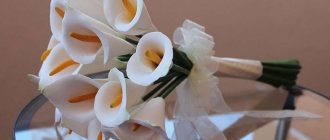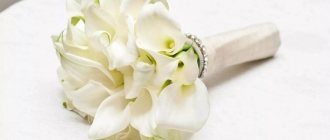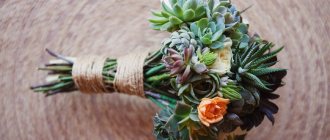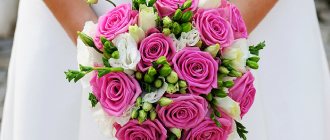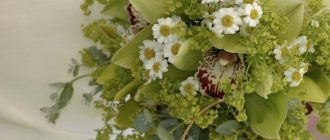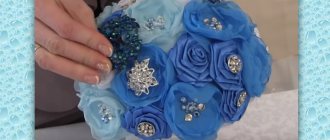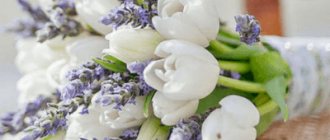These exquisite and interesting buds, reminiscent of a glass of champagne, are infrequent guests at a wedding celebration. But girls who know a lot about luxury and love to surprise give preference to just such plants. In our material we will look at how to choose the right bridal bouquet from callas, their symbolism, as well as combinations with other inflorescences.
Advantages
Resistant to any weather
Callas are not afraid of humidity, dampness, rain, frost, or hot weather conditions, which is why they are suitable for weddings in both warm and cold seasons.
Also, these flowers are resistant to drought, so you don’t have to carry a porta bouquet filled with water along with your bouquet, which will undoubtedly lighten the weight of the composition.
Long and strong stems
Your floral accessory will retain its original appearance throughout the holiday, not only because of its ability to withstand any vagaries of weather, but also thanks to its stems, which are strong, dense and thick in calla lilies, which is also an advantage of these plants.
By the way, you can make a bouquet of absolutely any shape from these flowers, due to their long stems. Real masterpieces are obtained in the form of cascading and round bouquets.
Pairs with many colors
Callas will look great:
- with roses;
- with freesia;
- with orchids;
- with asters;
- with alstroemeria;
- with eustoma;
- with gerberas;
- with carnations;
- and chrysanthemums.
When choosing companion flowers for calla lilies, you should know their sensitivity to weather conditions so that your composition remains intact and intact in its entirety, and not in part.
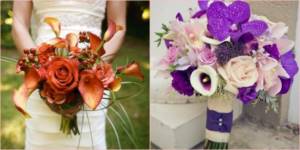
Unpretentious
Callas will delight the owner of the bouquet for 10-14 days. They will stand firm all this time in the water and retain their chic appearance.
Huge color palette
Callas have an incredibly wide range of colors, they come in:
- yellow;
- lilac;
- pink;
- creamy;
- white;
- purple;
- orange;
- wine;
- burgundy;
- blue;
- turquoise;
- blue;
- lilac;
- fuchsia colors;
- peach;
- coral;
- black.
Therefore, every newlywed can easily find a suitable and favorite shade for herself, maybe even more than one.

Who is this bouquet suitable for?
Calla lilies are not suitable for every bride. They best complement the image of a tall and stately girl. The bouquet should be harmoniously combined with the dress. It is worth choosing calla lilies to complement your wedding dress if you have a long and fairly narrow dress with a laconic silhouette. You should not overload such an image with decor - such a bouquet in itself looks very bright and impressive and obscures all other details.
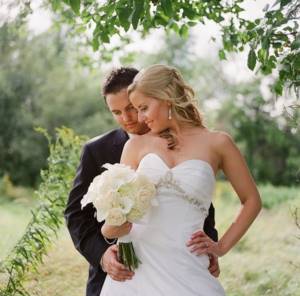
The ideal combination is calla lilies and a long mermaid dress, simple and devoid of rhinestones, sparkles and other elements. On a tall and slender girl, such an outfit, complemented by a discreet hairstyle and an elegant bouquet of delicate callas, will look great.
Symbolism
What does the flower mean?
Callas symbolize boundless respect, admiration, protection, tenderness and purity, and the yellow center of the bud speaks of courage and perseverance. The name of the flower translates as “beautiful.”
In some countries, it is customary to give calla lilies when a man proposes to his chosen one. He presents a bouquet along with a ring and asks her to become his wife.
What do the shades mean?
- Pink - patronage, protection and tender, trembling feelings.
- Red – passion, fire, flaming relationship between a couple.
- White - chastity and purity of the newlywed, as well as a new beginning and sublime love.
- Burgundy speaks of respect for family values, and they will also protect lovers from interference in their couple by third parties.
- Purple buds are a symbol of tender feelings between the bride and groom.
- Yellow symbolizes wealth, prosperity and success of the future family.
- Violet – respect, mystery and mystery.
In the spring and summer seasons, a pastel palette is perfect for the composition of the bouquet:
- pink;
- blue;
- peach;
- lavender;
- cream;
- lilac.

But in autumn and winter, use buds of rich, bright colors:
- brick red;
- orange;
- burgundy;
- purple;
- yellow.
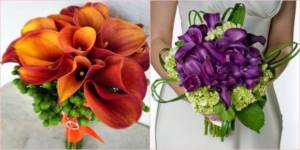
How to combine flowers in a bouquet correctly
Plants, like people, may not get along with each other. Florists understand this. In addition, each bouquet is a work of design art, so to create it you need to know the basics of this profession, for example, have an understanding of color theory.
How is the “livability” of plants manifested?
If the flowers are not chosen correctly, the composition will quickly wither. The fact is that all plants are capable of releasing specific substances into the water that affect other elements of the bouquet. When composing a composition, it is better to avoid combining antagonistic colors, including plants that are “friendly” to each other.
In this regard, in the flower world you can find:
aggressive or poorly compatible with other plants;
friendly, life-extending compositions that can purify water from bacteria;
Poorly compatible plants
Aggressive flowers include daffodils, orchids, mignonette, carnations, sweet peas, lilies of the valley, and lilies. Daffodils secrete a dense sap into the water that can clog the stems of other plants. It is better to place them in the same vase with others no earlier than a day later. Lilies of the valley have a particularly bad effect on forget-me-nots, tulips and violets. The lily accelerates the wilting of some wildflowers, such as cornflowers, poppies or daisies. Carnations do not tolerate roses in the vicinity.
Friendly plants
These include flowers that can extend the life of a bouquet, because the juice they secrete purifies the water from bacteria. These include geranium, branches of cypress, jasmine, woodruff stems. Cypress goes especially well with nasturtiums and tulips. Jasmine enhances the aroma of lilies of the valley and prolongs their life.
Combination of the most popular colors
Of course, experienced florists know an incredible number of flowers and their combinations, but the most common of them are roses, orchids, hydrangeas, lilies, peonies, tulips, and astelmerias. Their “getting along” with other colors can be examined in more detail.
Roses
Roses are friends with lilies, lilacs, callas, lavender, hydrangeas, alstroemerias, and gypsophila. It is not recommended to add tulips, poppies, carnations, delphiniums, lilies of the valley, and daffodils to them.
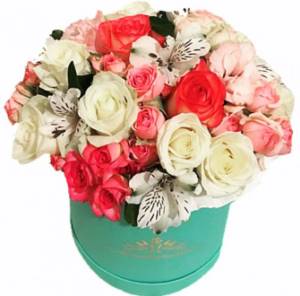
A bouquet of 17 roses, alstroemerias and eustomes in the “Jessica” box is a wonderful example of the compatibility of roses with other flowers. The composition will delight the eye for a long time. Flowers in boxes and baskets are a universal gift for colleagues, regardless of gender and age. This bouquet can also be given to a girl; the pink color hints at the romantic attitude of the giver.
Lilies
Pairs perfectly with phlox, daisies, irises, peonies, and primroses. It is not recommended to combine them with cornflowers and poppies.
Chrysanthemums
We can say that this is a neutral flower that can get along with almost everyone. True, some florists do not recommend adding more than one type of flower to chrysanthemums. So, the bouquet will be harmonious and durable if you add another type of buds, as well as greenery, to these flowers. You can also complement the composition with berries on a long stem. Gerberas, roses, and alstroemeria go especially well with chrysanthemums.
Peonies
Many florists do not recommend adding other flowers to a bouquet with peonies. However, it is possible to supplement them with hydrangeas, freesias, forget-me-nots, and daisies.
Tulips
Tulips coexist peacefully with many flowers; bouquets with chrysanthemums and roses are very successful. A combination with lilies, callas, alstroemerias, and irises is also acceptable.

A bouquet of irises and tulips “Evening Dawn”, although not unique in nature, is quite universal, because both irises and tulips are tenacious in themselves, resistant to our climate and go well with each other.
The above rules for color combinations are advisory in nature. In floristry, there are many nuances associated with flower varieties. For example, delphinium does not get along with large roses, but it coexists quite friendly with small bush roses. With proper care, seemingly incompatible flowers can stand together
long enough.
Color wheel concept
Nature has created a great variety of shades of buds. To combine them in a bouquet, you need to navigate the space
colors. There is a color wheel for this, which was invented along with early color theories. This is a body of knowledge about colors and shades, an entire science that includes two main sections: color science and coloristics.
The classic color wheel consists of eight sectors: the 7 colors of the rainbow, plus purple. Of these, half are considered basic (primary) - these are red, yellow, green, blue. The second half - intermediate (secondary) - are orange, blue, violet and purple. When two primary colors are added, a secondary color is obtained, which is located between them.
The color wheel is divided into two halves: warm and cold. Warm colors - red, orange, yellow, and their intermediate shades. Cool colors - blue, cyan, green, and their shades.
Four main ways to combine colors in floristry
Contrast
Contrast involves using opposite colors or shades on the color wheel in a composition. For example, orange and blue, yellow and green. Contrasting bouquets look bright and cheerful, but sometimes they can look unnatural. When composing such bouquets, florists require not only academic knowledge, but also their own sense of color and professional intuition.
Similar color scheme
The same thing is called a combination of colors that are adjacent to each other on the color wheel. The choice of plants with this color combination is much wider. After all, here it is not at all necessary to use pure colors; you can select shades. In this case, one of them can dominate. As a rule, such compositions look calm and restrained; there is no such riot of colors as in contrasting bouquets.
Monochromatic color scheme
This is a combination of buds of the same color, but different shades. That is, a bouquet of flowers of varying degrees of pink intensity can be considered monochrome. All transitions between shades should be smooth and not noticeable. To create such a composition, you can use flowers of different varieties - roses, peonies, chrysanthemums and so on.
A bouquet of 9 gerberas, 7 roses and 9 aspidistras “Pink Melody” was collected taking into account the monochrome nature of the buds. A monochromatic bouquet can complement any outfit and decorate the interior. This color scheme has its advantages: it looks strict and elegant.

Polychromatic color scheme
The polychromatic combination of the color palette is also called rainbow, since in this case all parts of the color wheel are used. The most common example is a bouquet of country or wildflowers. It is collected in the summer. Flowers that grew in the meadow at the same time, as a rule, look harmonious in a bouquet.
In one article we could not tell you all the nuances and subtleties of arranging bouquets. This is just a timid attempt to open the veil of a beautiful and interesting science - floristry. It is so deep that one can spend a lifetime understanding its secrets. Now you know the basic principles that experts use when composing bouquets. All that remains is to back up the theory with practice. We wish you inspiration and successful experiments!
Some tips
- Large luxurious bouquets, especially cascading ones, will perfectly highlight the beauty of tall brides. But miniature round compositions are perfect for small girls.
- Calla lily buds will look great when paired with straight dress styles such as mermaid, Grecian or empire.
- If you don’t want to get a motley, tacky and tasteless bouquet, then choose no more than three different flowers and shades for the composition.
- For a wedding in Art Nouveau style, ask the florist to make a bouquet of black and white buds, with the addition of iron abstract elements.
- The wedding flower arrangement must be in harmony with the groom's boutonniere and be made of the same flowers, in this case calla lilies.
What shape of wedding bouquet to choose
Callas are ideal for creating stemmed bouquets. They have their own long and strong stem, which is easy to fix and decorate. This form is simple, but gives the image sophistication and sophistication. Stem bouquets are assembled in a spiral and can combine several types of flowers. Several elements can be decorated in similar styles: the groom’s boutonniere, the bridesmaid’s jewelry.
Here are a few more flowers that you should definitely pay attention to when choosing a wedding bouquet: freesias, daisies, lilies, hydrangeas, peonies, roses, wildflowers, orchids.
Assembling a basket-shaped bouquet with calla lilies will be problematic, and it won’t look as impressive. And the cascade option looks amazing! Especially if combined with orchids. A bouquet of calla lilies can be given an unusual shape if the celebration is held in a certain style.
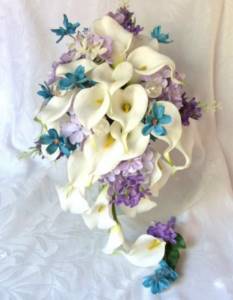
Cascading wedding bouquet with callas
Flower decor
Bouquets are usually decorated with:
- pearls;
- satin ribbons in the color of the celebration;
- fur;
- beads;
- bows;
- fabric drapery;
- lace
Modern newlyweds often ask to add berries, cotton, pine cones, peacock feathers or brunia to the composition. What exactly you choose will depend on the style of your wedding day and the season.
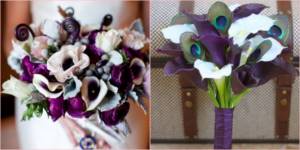
Beautiful flowers - callas
Africa (South) is considered the birthplace of callas. In nature, under natural conditions, these plants reach a height of up to 2 meters, possibly more. Ethiopian varieties are considered the most common on the market today.
The main feature of these flowers is their unpretentiousness and at the same time elegance, which contributes to the fact that calla lilies are usually the basis of the composition of a wedding bouquet.
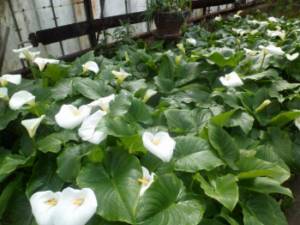
Variety of shapes
Bouquets come in various shapes, below we will look at the most common ones:
- Round It can be very small or larger. Most often it is made from callas in combination with any other plants, for example, roses, gerberas, freesia or carnations.
Advice! A wonderful idea is to wear a short wedding dress and choose a round floral accessory.
- Cascade - chic voluminous bouquets, they are also called a waterfall. Most often they look catchy and unusual. Florists have only recently begun to make such bouquets for weddings, but they have already won the love of many brides. The cascade often also includes roses, lilies or orchids.
- Elongated – it is ideally obtained from these plants, because calla lilies have long stems.
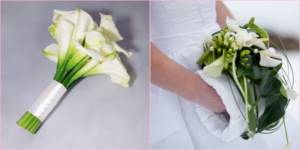
- The muff is made of fur or thick fabric, and flowers are placed on top. This is the latest trend among bouquets in wedding fashion. A wonderful option for winter, which will warm the girl’s hands, fit into the overall theme of the holiday, surprise guests, and make the newlywed stand out from the crowd of other couples.
Ideas from florists
If you want to make an original bridal bouquet from calla lilies, be guided by the photo and follow the instructions.
You will need:
- callas;
- carnations;
- White Rose;
- bush roses;
- brunia (optional)

Before assembling, you need to prepare the flowers - cut off the excess length of the stems.
- The calla is located in the center, its edges should protrude above the level of other flowers. Next to her are a large white rose and a carnation. The bouquet is collected in a spiral.
- Spray roses and silver brunia are added.
- Along the edges there are large white roses.
- After assembly, the stems are fixed in two places.
- The cut of the bouquet should be clear. The stems are trimmed with pruning shears.
- The leg is decorated with a neutral colored ribbon. The tape is not wound around the stems; after a few turns it is secured with a pin. The edge of the tape is folded inward and secured with a pin at an angle of 45 degrees.
- Additionally, you can decorate the leg with lace.
Interesting! Pay attention to compositions of other colors. Bouquets of spray roses or orchids look very beautiful.
Beautiful combinations
With roses
A classic of the genre is a version of the bouquet when it contains roses. Due to the fact that they are quite resistant to any weather conditions, they are sold throughout the year, they have many shades, shapes and varieties from which you can find the ones you need and like, which is why they are often added to the composition, especially for a wedding.
For the composition of floral accessories, tea, bush, and large varieties of roses are used. In any case, they will harmonize perfectly with calla lilies.
By the way, such combinations can easily do without greenery, because both buds look self-sufficient, textured and elegant.
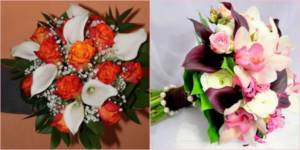
With orchids
These exotic plants are varied in their shape and color, so they also deserve to be in the hands of the newlywed. They look ideal in combination with callas in a cascading bouquet. They complement each other wonderfully and look very elegant and interesting.
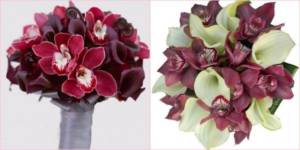
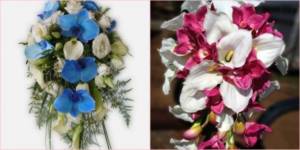
With eustoma
It has long earned the title of one of the most common flowers in a bouquet. It looks a little like roses, which is probably why it is often combined with various plants, including callas.
There are a huge number of examples of combinations:
- blue, blue or lilac eustomas look great with yellow or orange callas;
- you can take a white bud as a base and add a brighter eustoma;
- Pastel shades also harmonize well with each other.
Advice! Wildflowers, roses, orchids and greenery will be wonderful additions to these plants.
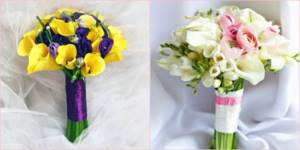
With gerberas, chrysanthemums and carnations
These compositions are a good idea only because these inflorescences, like calla lilies, are resistant to various weather conditions, especially cold ones. It would be a great idea to choose such a masterpiece for a winter wedding.
Bouquets in any color scheme will look chic, as well as with the addition of greenery, as well as other flowers, for example, roses, which are also not afraid of frost.

Gerberas
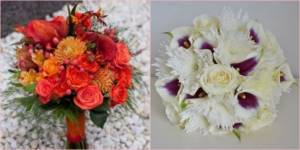
Chrysanthemums

Carnations
Monobouquet
Callas are stunning plants with unusual buds that can surprise and captivate many. Therefore, feel free to use only them for the composition of your composition, but you need to choose the right shades, because:
- a white floral accessory will emphasize the tenderness, purity and innocence of the bride;
- pink – adds romance;
- purple – will add mysticism and mystery;
- black - suitable for bold, extravagant girls who are not afraid to experiment even on such an important day for themselves.
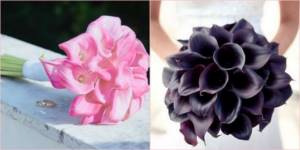
Tandem with orchids
A bride's wedding bouquet of callas and orchids will look best in light shades. In this case, the majesty of such a range will be emphasized by green leaves. However, the original ensemble with orchids is not suitable for everyone. It will be truly original for tall girls dressed in retro style.
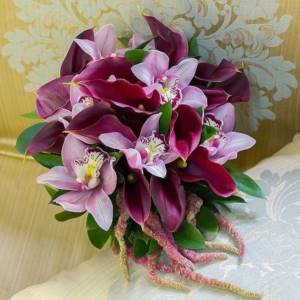
Wedding bouquet of flowers for the bride from callas and orchids
The variety of colors allows you to create bouquets in almost any color. A combination of white and yellow flowers looks good with purple orchids. They cannot but captivate with their irresistibility, variety of appearance and lines. Fragile orchids look stunning together with hardy calla lilies. To keep orchids longer, their stems need to be placed in a floral container.
It should be borne in mind that there are many varieties of these flowers. Their difference is in the length of the rhizome and the size of the inflorescences. For large buds on long stems, an oblong composition is suitable . As for miniature flowers on short stems, they look good in rounded compositions.
Compositions of traditional tones will look ideal at ordinary weddings, provided that the style of the outfit is taken into account. It should be in the spirit of minimalism, without excessive pomp, from which the bouquet can lose all its sophistication.
Bright bouquets of unusual shades go well with eye-catching decorations and accessories. These can be extravagant shoes, watches, earrings, chains, rings
Additional photos with examples
Packaging Features
Any bouquet complements the decoration. Packaging materials are chosen depending on the composition of the bouquet and the reason for the gift. A suitable design will complement the composition and give it completeness.
Monobouquet design options:
- The composition in a hat box looks truly luxurious and elegant. This is a wonderful gift for any holiday. You can decorate the box with beads, ribbon, bow or greeting card.
- A mono-bouquet in a decorative basket looks presentable and expensive. The composition can be presented to your mother, mother-in-law, mother-in-law or women's group for any celebration.
- Organza. Delicate light fabric will complement a flower arrangement for a girl or wife. A lace or silk ribbon will add elegance and tenderness to the bouquet.
- Decorative mesh. This packaging is suitable for a bouquet of wild or garden flowers. The composition can be given to anyone who appreciates natural beauty.
- A mono bouquet tied with ribbon, thread or rope - simple and tasteful. A great gift for a loved one on a holiday or just for no reason. The ribbon can be decorated with pearls or beads.
Bouquets of calla lilies Description of the flower, its symbolism, care.
Calla is a very elegant flower. Its shape is simple: only one petal wraps around a yellow candle. But in this simplicity lies its elegance. The most common color of calla lilies is white. Few people know that callas come in a variety of shades: green, pink, purple, yellow, orange and even black. That is why they are sometimes called “tropical butterflies.” This extraordinary flower comes from South Africa.
Snow-white specimens have a long stem, which can reach 50 cm. But colored callas are only short.
Callas symbolize beauty, tranquility, and respect. People have long noticed that these flowers bring peace to the house and protect the family from quarrels and disagreements. That is why a bouquet of calla lilies is ideal for a wedding celebration. Some associate this flower with funerals and are afraid to form their wedding bouquet from callas. This is a big misconception. Callas, on the contrary, have been a talisman of marital happiness since ancient times. If you choose calla lilies for a wedding bouquet, then choose a variety with dark green leaves. They will wonderfully contrast with the white flower petals, and at the same time will not allow the bouquet to merge with the bride’s dress. Also remember that bouquets of calla lilies do not go well with elaborate, lush outfits. These simple flowers love the same simple and elegant forms of dresses. The strict and impeccable look of callas. symbolizing respect, allows you to make business and official bouquets from them. These unpretentious flowers can also be given to a man.
The shape of the bouquet of callas will depend on the length of the stem. You can make an elongated bouquet from tall flowers, and a round bouquet from short ones. Keep in mind that a round bouquet will require more flowers (15-19 pieces), since the inflorescence of calla lilies is not voluminous, but elongated. Calla lilies can be combined with other flowers in a bouquet, but mono-bouquets look no less successful. A bouquet of callas should not be overloaded with various decorations. They will argue with the rigor and minimalism of this flower. This wonderful plant also has some disadvantages. So, its peculiarity is a specific pungent odor. Therefore, it is better not to present such flowers to allergy sufferers or people who are particularly sensitive to odors (for example, pregnant brides). In addition, these flowers are quite expensive. A bouquet of callas will cost you more than a bouquet of roses. And you need to order such a bouquet in advance, because not all flower salons work with calla lilies. Despite these shortcomings, many cannot resist the magnificence of these flowers and give their preference to them.
Callas are quite persistent flowers; they do not fade for a long time. All they need is clean, cold, fresh water. And if you trim their stems a little, the flowers will delight your eye for several weeks.
These amazing flowers, combining severity and tenderness, will become a wonderful decoration for your home. Callas will highlight the taste and originality of the person who chose this flower. They can also become a unique decoration for any celebration.
anflo.ru
Florist lessons. Making a bouquet of callas at home
I won't tell you when to plant calla lilies or where to grow them, I will tell you how to use these delicious flowers. They have long been used for bouquets, and I will teach you how to make beautiful bouquets for the bride or for a celebration.
First I will show you the bouquet we will receive. These are thirty tightly knit callas of the same length. We will receive such a bouquet, tied with a ribbon, upon completion. This is what we will get in the end, and now let's get started.
I have flowers. Usually they are tied very tightly with braid or some kind of tape and placed in a plastic container, which also holds them together. First of all, we need to make fresh cuts to trim them. It is best to use a small, sharp knife. If you don't have a special garden knife, use a sharp kitchen knife. Make a small cut and immediately place the plant in a container of water. By the way, there should be very little water in the vessel, literally at the bottom. She doesn't need much fluid. If you pour a lot of water into the vase, the stem will become slimy, which is not what we want. Once you have done this, start making your bouquet. I usually start with three pieces. I select the first three calla lilies, and then add others to them, focusing on height. They should all be at the same height. When collecting flowers in a bouquet, hold them in your hand. It is not necessary to squeeze them tightly, you just need to immediately place them in the correct position. Add flowers in a circle rather than on one side.
Everything must be consistent. Next you will need white tape and braid. You can use other materials, but these are the easiest to work with. In addition, they compress the flowers tightly without damaging them. You can purchase these materials both in a regular store and in a florist. Sometimes it can be a little difficult to squeeze all the stems if there are a lot of them. Then I recommend tying them lightly with braid and continuing to add flowers in a circle. When you arrange all the flowers, make sure they look good. After this, we take the braid and tie it for the first time.
It’s good when the braid has an adhesive backing. After this, you need to trim the stems so that they are exactly the same length. Then we take a white ribbon and wrap it around half the stem. You can secure the ribbon using small pins.
That's all. You made a great wedding bouquet. It's very easy to make. Also use bouquets for any celebration.
homesgardens.com
